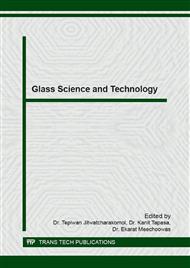p.77
p.83
p.91
p.96
p.103
p.108
p.113
p.121
p.125
Composition of Kaew Angwa by X-Ray Fluorescence Spectroscopy (XRF)
Abstract:
The ancient glass, “Kaew Angwa” is a kind of materials used in decorative art work with colored glass casted on metal. The common Kaew ANgwa can be found in green, blue, colorless and yellow. Brown and red Kaew Angwa are rather scarce. Thin sheet of colored glass is tightly bonded to the metal which cracks when it is bent but still stays intact. Kaew Angwa can reflect lights to the colors of the colored glasses beautifully. Kaew Angwa can be cut with scissors which make it’s easiness for ornament.In this presentation, composition of Kaew Angwa will be examined by X-Ray Fluorescence Spectroscopy (XRF). The colored glass will be identified and shown that the insertion of transition metals (iron, manganese, and copper) into the crystal structure of silica causes Kaew Angwa to be colored.There is no known method to fabricate Kaew Angwa to be exactly like the ancient one. The results from this work will give the general idea on the composition of colored glasses. Several trials have been performed on how to bond colored glass and metal, for example silver mirroring on cover glass and sealed with epoxy for protection. Further experiments will be performed on thin colored glass
Info:
Periodical:
Pages:
103-107
Citation:
Online since:
July 2016
Authors:
Price:
Сopyright:
© 2016 Trans Tech Publications Ltd. All Rights Reserved
Share:
Citation:


